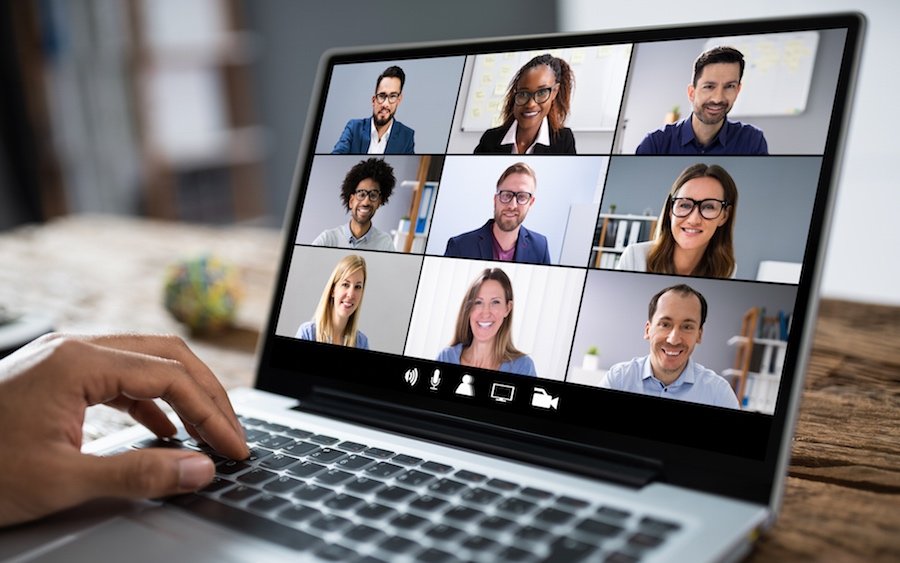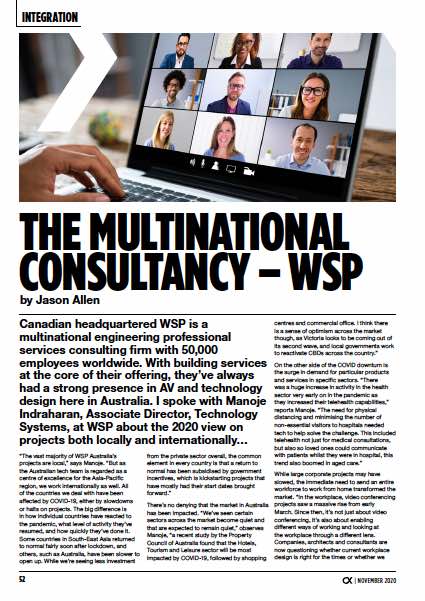Integration
12 Nov 2020
The Multinational Consultancy – WSP

Subscribe to CX E-News
Canadian headquartered WSP is a multinational engineering professional services consulting firm with 50,000 employees worldwide. With building services at the core of their offering, they’ve always had a strong presence in AV and technology design here in Australia. I spoke with Manoje Indraharan, Associate Director, Technology Systems, at WSP about the 2020 view on projects both locally and internationally…
“The vast majority of WSP Australia’s projects are local,” says Manoje. “But as the Australian tech team is regarded as a centre of excellence for the Asia-Pacific region, we work internationally as well.
“All of the countries we deal with have been affected by COVID-19, either by slowdowns or halts on projects. The big difference is in how individual countries have reacted to the pandemic, what level of activity they’ve resumed, and how quickly they’ve done it.
“Some countries in South-East Asia returned to normal fairly soon after lockdown, and others, such as Australia, have been slower to open up.
“While we’re seeing less investment from the private sector overall, the common element in every country is that a return to normal has been subsidised by government incentives, which is kickstarting projects that have mostly had their start dates brought forward.”
There’s no denying that the market in Australia has been impacted.
“We’ve seen certain sectors across the market become quiet and that are expected to remain quiet,” observes Manoje, “a recent study by the Property Council of Australia found that the Hotels, Tourism and Leisure sector will be most impacted by COVID-19, followed by shopping centres and commercial office.
“I think there is a sense of optimism across the market though, as Victoria looks to be coming out of its second wave, and local governments work to reactivate CBDs across the country.”
On the other side of the COVID downturn is the surge in demand for particular products and services in specific sectors.
“There was a huge increase in activity in the health sector very early on in the pandemic as they increased their telehealth capabilities,” reports Manoje.
“The need for physical distancing and minimising the number of non-essential visitors to hospitals needed tech to help solve the challenge. This included telehealth not just for medical consultations, but also so loved ones could communicate with patients whilst they were in hospital, this trend also boomed in aged care.”
While large corporate projects may have slowed, the immediate need to send an entire workforce to work from home transformed the market.
“In the workplace, video conferencing projects saw a massive rise from early March. Since then, it’s not just about video conferencing, it’s also about enabling different ways of working and looking at the workplace through a different lens.
“Companies, architects and consultants are now questioning whether current workplace design is right for the times or whether we should be looking at the issue from an entirely different perspective.
Companies, architects and consultants are now questioning whether current workplace design is right for the times
“We’re looking at smart signage, smart lockers, heat mapping, staff distancing, touch free control systems and desk booking systems, the last of which we’re currently implementing around the world.
“It’s all about managing people’s movements and interactions while granting more flexibility.”

With the shift en-masse to remote working, there’s been ample talk of the collapse of commercial office space, and large corporates abandoning big CBD offices for something more affordable. Is this hype or what big corporates are actually contemplating?
“Six months ago, I’d have given a different answer,” contemplates Manoje. “At the start of the pandemic, people thought we’d abandon office spaces all together, but as time has passed, we’ve seen a social and mental health element that just can’t be addressed by technology, and businesses are aware of this.
“The office as we know it will not go away, but will be reimagined. Some corporates I’ve spoken to were considering consolidating satellite offices into a single head office, but now they’re rethinking that the satellites are a better option, giving a balance between working near home, from home, and coming into HQ to meet with co-workers. In my opinion, that’s the better model.”
Working for a multinational himself, Manoje can appreciate the complexities and challenges that organisations are now facing as they work to reactivate their offices.
“The sentiment across the market is that staff have become comfortable working from home, yet there’s no replacement for the collaboration and innovation that an office environment fosters.
“What that means is that we need to be re-thinking the way an office supports its occupants; so, if you’re coming into the office, you’re doing it for a specific purpose and the office has been designed around that.”
we need to be re-thinking the way an office supports its occupants; so, if you’re coming into the office, you’re doing it for a specific purpose and the office has been designed around that
With so many in the workforce experiencing a sudden and dramatic shift in the tools they use to communicate, hundreds of thousands of people are now comfortable with a technology they previously had limited exposure to.
“I’ve noticed in the last couple of months that people are now talking about what is good versus bad quality video conferencing. People can now differentiate between a proper integrated solution and a ‘hang-and-bang’.
“While there are countless out-of-the-box solutions for self-install, my concern is that it’s not going to support your staff with a better video conferencing experience.
“I’m hearing this all the time now from different sectors; people are already getting really annoyed with low quality video conferencing.”
The huge uptake of video conferencing has propelled the technology forward the best part of a decade. “Video conferencing becoming not only normal, but available on multiple devices is a massive change in the workplace,” marks Manoje.
“Regardless of age, your working status, or who you are, you’re used to it now. What will be exciting is how we’ll now see that being integrated with smart building tech, alongside other building systems like automation and control.
“The big upside will be using the data analytics and artificial intelligence to better utilise spaces and manage physical distancing policies implemented by the company or even by Government policy.
“While the current level of integration of AI within AV or smart building systems varies across different implementations, there have been some really clever use cases.
“Room booking is a good example; if you’ve booked a seven-person room and eight people have accepted the meeting request, the meeting room AI might rebook to a larger room, taking into consideration any distancing requirements.
“Conversely, if only three people respond, the AI might automatically reallocate your meeting to a smaller room and make the larger room available for others.
“We’re deploying systems with this capability right now.”
With a global perspective through WSP, Manoje notes the effects of the virus are universal, as is the reaction to them.
a common element connecting us all is uncertainty – in Kenya they’re looking at the exact same technological solutions as we are in Australia, and the US
“I’m working on a project in Kenya at the moment. This global experience of COVID, regardless of in which country and under which circumstances, everyone’s going through it together.
“There’s a common element connecting us all, which is uncertainty. Even in Kenya, they’re looking at the exact same technological solutions as we are in Australia, and the US.
“Even though we all like to think of ourselves as innovative, we’re all trying to solve the same problems.”
WSP
www.wsp.com
CX Magazine – November 2020
LIGHTING | AUDIO | VIDEO | STAGING | INTEGRATION

Entertainment technology news and issues for Australia and New Zealand
– in print and free online www.cxnetwork.com.au
© VCS Creative Publishing
Subscribe
Published monthly since 1991, our famous AV industry magazine is free for download or pay for print. Subscribers also receive CX News, our free weekly email with the latest industry news and jobs.








